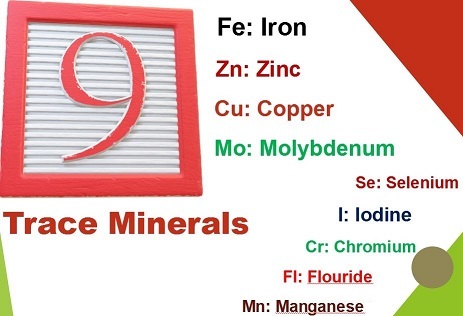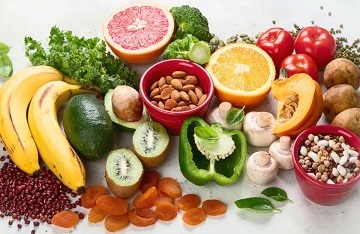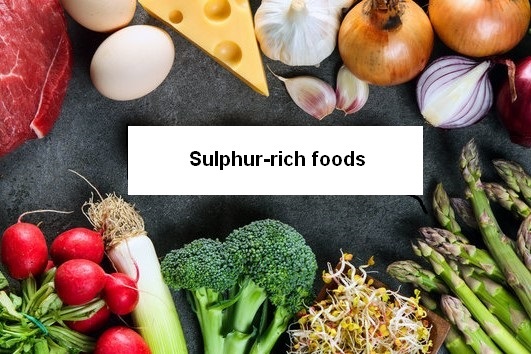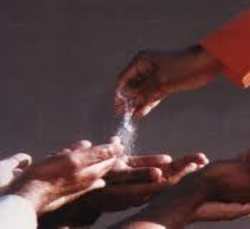In Addition
Vol 15 Issue 2
March / April 2024
1. Health Article
Plan a balanced intake of Minerals – essential micronutrients for health!
“The food that we eat contains many metals like copper and iron. Iron content is more in leafy vegetables. Tamarind and lemon preparations develop “amla”, which is the basic constituent in the formation of cells. In this manner, food strengthens our body…generates blood and energy in the body. Every drop of blood in your body is suffused with divinity. This divine energy has to be properly utilised by entertaining divine thoughts.”…Sathya Sai Baba1
In the previous issue of this newsletter, we dealt with vitamins; this article will delve into minerals, the other micronutrients.
1. What are Minerals?
Minerals are compounds of one or more elements, mostly inorganic, that plants obtain from rock, soil, and water. There are over 5000 minerals used widely in fertilizers and food. We will concern ourselves with those that our bodies need to survive, develop, and function properly.2-5
2. Minerals for health
2.1 Essential minerals: The sixteen minerals considered essential to sustain the human body are:
(i) Seven macro/major minerals: calcium, phosphorus, potassium, magnesium, sodium, chloride, and sulphur; the needed amount of each is 0.1 to 1 g/day and (ii) Nine trace minerals: iron, copper, zinc, molybdenum, selenium, iodine, chromium, fluoride, and manganese, needed in very small quantities, less than 100 mg/day.6,7


They are the building blocks of life, the natural sources of all these minerals being vegetables, whole grains, legumes, nuts, seeds, fruits, and dairy products.8
2.3 Role of minerals: Minerals become part of the tissue structure, maintain water and acid-base balance, regulate body processes, nerve and muscle functions, and release energy from food. They ensure optimum functioning of the immune system and prevent susceptibility to infection and development of chronic disease.6,9
3. Macro minerals
3.1 Calcium (Ca), the most abundant mineral in the body, it is the primary building material of bones and teeth and it nourishes the cells and ensures normal blood clotting. The greatest need for 
 calcium is in childhood, adolescence, and for women during pregnancy and breastfeeding.7
calcium is in childhood, adolescence, and for women during pregnancy and breastfeeding.7
Ca is not easily absorbable even from some excellent sources like milk and its products, tofu (soy cheese), fortified orange juice (around 30% is absorbable), dried beans, peas, dry roasted almonds, sesame seeds, sweet potatoes (20-25%), and spinach (hardly 5% due to its high oxalates). But other leafy greens and cruciferous vegetables like kale, cauliflower, broccoli, Brussel sprouts, cabbage, and radish are good sources with a higher bio-absorption of nearly 50-70%.7,10,11
Deficiency/Excess: Ca deficiency will bring about the same bone problems as caused by lack of vitamin D.7 Further, low Ca in the blood may result in dry scaly skin, brittle nails, coarse hair, and muscle cramps in the back and legs; over time it can affect the brain. Extremely low level will show up as tingling, spasm, seizure, and abnormal heart rhythm.12 Excess Ca can block the absorption of iron and zinc and increase the risk of constipation, kidney stones, and prostate cancer.10
3.2 Phosphorous (P) is the second most abundant mineral in the body that makes the building block of our genes, activates the enzymes and balances the blood pH.13
Caution: Those following low “P” diet on medical advice should avoid processed foods and cola drinks containing hidden and  easily absorbable phosphorous.7,13
easily absorbable phosphorous.7,13
3.3 Potassium (K): This third most abundant mineral in the body is an electrolyte and maintains normal levels of fluid inside our cells. Potassium is lost daily through stool and sweat and needs to be replenished with both hydration and a good diet. It can help  reduce blood pressure and water retention, protect against stroke, and prevent osteoporosis and kidney stones.14-16
reduce blood pressure and water retention, protect against stroke, and prevent osteoporosis and kidney stones.14-16
3.4 Magnesium (Mg): It is important for strong bones and steady heartbeat, blood sugar, and blood pressure. Mg can prevent leg and foot cramps and help treat some chronic diseases like migraine,  Alzheimer’s disease, cardiovascular issues, and type-2 diabetes, aid better sleep, and alleviate mood disorders and premenstrual syndrome. It is naturally present in a variety of fibre rich wholefoods, highest in pumpkin seed kernels, almonds, spinach, black beans, and dark chocolate. For more details refer to health article, vol 5 #4, July-Aug 2014.17-20
Alzheimer’s disease, cardiovascular issues, and type-2 diabetes, aid better sleep, and alleviate mood disorders and premenstrual syndrome. It is naturally present in a variety of fibre rich wholefoods, highest in pumpkin seed kernels, almonds, spinach, black beans, and dark chocolate. For more details refer to health article, vol 5 #4, July-Aug 2014.17-20
Caution: Mg is present in popular antacids; high doses can have a laxative effect.17
3.5 Sodium (Na): It is a 40% component of common salt (NaCl) and an electrolyte to maintain the fluid levels around the cells. Fruits, vegetables, whole grains, nuts, and dairy are low in Na but  enough for the body. As the body needs not more than 500mg of Na (¼ tsp of salt) per day, deficiency is rare; it may occur in older adults esp. after a bout of excess vomiting, diarrhoea, or sweating, see health article, vol 14 #3, May-June 2023.21,22
enough for the body. As the body needs not more than 500mg of Na (¼ tsp of salt) per day, deficiency is rare; it may occur in older adults esp. after a bout of excess vomiting, diarrhoea, or sweating, see health article, vol 14 #3, May-June 2023.21,22
Caution: High sodium and low potassium diet can be a health risk and can damage the heart, kidneys, and bones even without increasing the blood pressure. Sodium is not a nutrient we need to look for; rather it finds us through hidden salt in processed and packaged items. For high sodium foods, see vol 3 #3, May-June 2012. Do not be liberal with sea or rock salt presuming these to be healthier, as Na content of all salts is the same.21,23,24
3.6 Chloride (Cl): A 60% component of salt and an electrolyte like sodium and potassium, it regulates the amount of fluid and types of nutrients going in and out of cells. Also, it maintains proper pH levels, stimulates the stomach acid needed for digestion, and facilitates the flow of oxygen and carbon dioxide within the cells.25
3.7 Sulphur (S): Abundant in the body equivalent to potassium, it is anti-inflammatory, protects against cellular damage and oxidative stress, builds and repairs DNA, helps in synthesis of  antioxidants, maintains nitrogen balance, inhibits some harmful bacteria and is good for skin, hair, and nails. It can treat acne, eczema, arthritis, pains, and digestive issues.26-28
antioxidants, maintains nitrogen balance, inhibits some harmful bacteria and is good for skin, hair, and nails. It can treat acne, eczema, arthritis, pains, and digestive issues.26-28
Foods high in sulphur are onion, garlic, broccoli, cauliflower, and cabbage, best when cooked for joints and the immune system; also, legumes, lentils, nuts, and seeds.26,27
4. Trace minerals
4.1 Iron (Fe): Essential to make haemoglobin and myoglobin that carry oxygen to all parts of the body and store it in muscle tissues. Fe is vital for healthy brain development and growth in children and the normal functioning of various cells  and hormones. It nourishes skin and hair, reduces dark circles around the eyes, improves sleep quality and memory, enhances sports performance, and ensures a healthier pregnancy. Symptoms of deficiency are reduced energy, extreme fatigue, lightheadedness, sensitivity to cold, shortness of breath, rapid heartbeat, pale skin, hair loss, brittle nails, and pica (craving for dirt, clay, ice, or other non-food items).29,30
and hormones. It nourishes skin and hair, reduces dark circles around the eyes, improves sleep quality and memory, enhances sports performance, and ensures a healthier pregnancy. Symptoms of deficiency are reduced energy, extreme fatigue, lightheadedness, sensitivity to cold, shortness of breath, rapid heartbeat, pale skin, hair loss, brittle nails, and pica (craving for dirt, clay, ice, or other non-food items).29,30
Vegetarian wholefoods are rich in iron esp. millets like finger millet (Ragi), nuts, dates, black sesame seeds, pumpkin and hemp seeds, legumes like kidney beans, chickpeas, green leafy vegetables, beets, carrots, potato with skin, sweet potato, moringa leaves, fruits like black olives, mulberries, prunes, pomegranate, apples, and tofu, dark chocolate, and fortified breakfast cereals. Using a cast iron pan can transfer iron to food while cooking. Fe is absorbed better in the presence of protein and vitamin C; adequate vitamin A helps release stored iron.29-34
Caution: Do not drink tea or coffee at least an hour before and after meals as tannin in tea or coffee can reduce iron absorption.31,32
4.2 Copper (Cu): Found in body tissue it helps to make red blood cells, healthy bones and nerve cells, and in absorption of iron; it can prevent and delay arthritis. Water stored overnight in  copperware can provide this mineral. A copper imbalance is linked to Alzheimer’s disease. High intake of zinc or vitamin C supplements can block its absorption and cause deficiency. Lack of Cu may lead to anaemia, high BP, cardiovascular diseases, osteoporosis, and loss of skin pigment.35-37
copperware can provide this mineral. A copper imbalance is linked to Alzheimer’s disease. High intake of zinc or vitamin C supplements can block its absorption and cause deficiency. Lack of Cu may lead to anaemia, high BP, cardiovascular diseases, osteoporosis, and loss of skin pigment.35-37
Caution: Adding lemon/lime juice or anything sour to drinking water in a copper vessel can cause a reaction, resulting in stomachache, nausea and vomiting. Also, read our health article, vol 8 #3 May-June 2017.37-39
4.3 Zinc (Zn): Essential for the growth of cells, building proteins, healing damaged tissue, and a healthy immune system, Zn is crucial during childhood, adolescence, and during pregnancy for healthy foetal development. Signs of deficiency are loss of taste or smell,  depressed mood, delayed wound healing, and hair loss. Ointments containing zinc can protect from sunburns and treat inflamed conditions like burns, eczema, bedsores, and diaper rash. 40
depressed mood, delayed wound healing, and hair loss. Ointments containing zinc can protect from sunburns and treat inflamed conditions like burns, eczema, bedsores, and diaper rash. 40
4.4 Molybdenum (Mo): A hardly known mineral found in many fibre-rich foods like black-eyed peas, lima beans, and peanuts, it has a crucial role in detoxifying the body from harmful  substances by breaking down proteins, alcohol, drugs, toxins, purines that form uric acid (a risk factor for gout), and deadly sulphites.41,42
substances by breaking down proteins, alcohol, drugs, toxins, purines that form uric acid (a risk factor for gout), and deadly sulphites.41,42
4.5 Selenium (Se): It protects against cell damage and infection,  increases immunity against viruses including HIV, helps in the reproduction and metabolism of thyroid hormones, and reduces asthma symptoms. It has a synergistic relationship with iodine important for a healthy thyroid; too much of one can contribute to the deficiency of another. Alone or in combination with vitamin E, it acts as an antioxidant and is known to decrease cancer risk.43,44
increases immunity against viruses including HIV, helps in the reproduction and metabolism of thyroid hormones, and reduces asthma symptoms. It has a synergistic relationship with iodine important for a healthy thyroid; too much of one can contribute to the deficiency of another. Alone or in combination with vitamin E, it acts as an antioxidant and is known to decrease cancer risk.43,44
Present in tofu, cottage cheese, mushrooms, navy beans, sunflower seeds, oats, and fortified cereals, selenium is exceptionally high in Brazil nuts. Symptoms of deficiency are fatigue, brain fog, muscle weakness, thyroid dysfunction, hair loss, infertility in men, poor immune function, osteoarthritis, and heart disease.43,44
4.6 Iodine (I): Essential to make thyroid hormones, it helps in regulating body temperature, brain development before and after birth, breathing, and heart health, and prevents hypothyroidism and goitre – refer to health article on thyroid in newsletter vol 10 # 6, Nov-Dec 2019). It also helps to disinfect and heal mild cuts, wounds, and burns. Good vegetarian sources are dairy, soya-based foods, iodised salt, and a healthy balanced diet.45-47
Symptoms of low iodine are fatigue, lethargy, sensitivity to cold, dry skin and hair, weight gain, and fibrocystic breasts. Too much can cause irregular menses, rapid heartbeat, hand tremors, sweatiness, sleep issues, and weight loss.45,46
4.7 Chromium (Cr): Essential for the metabolism of sugar and fat, the biologically active Cr is present in most plant foods, brewer’s yeast, and coffee; also, in drinkable tap water and food cooked in stainless-steel vessels. Vitamin B3 (niacin) and vitamin C enhance its absorption. For infants, the ideal amount is present in the breast milk of healthy mothers.48,49
4.8 Fluoride (Fl): Naturally found in water, brewed black tea and coffee, oatmeal, raisins, and potatoes and in mouthwash and toothpaste*, it prevents and reverses early tooth decay and remineralizes tooth enamel. Also, benefits those having dry mouth, gum disease, history of tooth decay, or crowns, bridges, braces, or removable dentures; crucial for children between the ages of six months and 16 years.50,51
Deficiency can lead to dental caries and bone problems. Excess can cause nausea, vomiting, abdominal pain, diarrhoea, joint pain, skeletal fluorosis or bone loss. In places like India in the fluoride belt, steps are taken to remove it from water when it exceeds the prescribed limit of 1mg/L. Fluoride can be removed from drinking water through reverse osmosis (RO) filters.50-52
*Caution: Some studies show fluoride having a neurotoxic effect; minimise the use of fluoride toothpastes esp. for children up to age 6 to prevent fluorosis; look for better alternatives.53,54
4.9 Manganese (Mn): A lesser-known mineral but vital for building bones, immune and nerve function, and reproductive system, it works with vitamin K to assist in wound healing by clotting blood. Both Fe and Mn work together and are often found in the same foods.55,56
4.10 Boron (B): A hitherto unrecognised trace mineral, is considered important for bone and brain health, wound healing, balancing reproductive hormones, alleviating arthritis, and has  anticancer properties. It is found as boric acid in many foods, esp. beans, nuts, whole grains, avocados, berries, plums, oranges, and grapes.57,58
anticancer properties. It is found as boric acid in many foods, esp. beans, nuts, whole grains, avocados, berries, plums, oranges, and grapes.57,58
5. Tips
- Take a variety of foods at the same meal. Avoid eating large amounts of a single food because too much of one mineral can interfere with the absorption and functioning of others.59
- Good cooking practices like soaking, sprouting, fermenting of wholegrains and steaming of cruciferous and leafy vegetables will help better absorption of minerals. Unlike vitamins minerals are not damaged by heat or light though they can be lost in excess cooking water.57
- Limit sugar intake, excess can deplete your intake of essential minerals.60,61
- Minerals are best absorbed from natural organic foods, not from supplements. However, the global use of chemical fertilizers, pesticides, and mass production has degraded the soil necessitating supplements to avoid chronic deficiency.62,63
Final word: Pay attention to your body’s needs. Do not underestimate the importance of both major and trace minerals in diet which are very powerful and vital for health.
References and Links
- Sathya Sai Speaks,” Purify the Mind and Focus it on Divinity”, Dasara Discourse, Day 5, 13 October 2002: https://www.sathyasai.org/discour/2002/d021013.html
- How minerals evolved: https://www.earthdate.org/episodes/minerals-evolve-too
- Source of minerals: https://www.health.harvard.edu/staying-healthy/precious-metals-and-other-important-minerals-for-health
- Natural elements: https://www.thoughtco.com/how-many-elements-found-naturally-606636#
- Usage of minerals: https://courses.lumenlearning.com/suny-monroe-environmentalbiology/chapter/minerals/
- Essential Minerals: https://extension.okstate.edu/fact-sheets/minerals-and-the-body.html
- https://www.edubloxtutor.com/essential-minerals-your-body-needs/
- https://www.news-medical.net/life-sciences/What-Chemical-Elements-are-Found-in-the-Human-Body.aspx#
- Minerals for immune system: https://www.ncbi.nlm.nih.gov/pmc/articles/PMC8840645/#
- Large macro mineral Calcium: https://www.hsph.harvard.edu/nutritionsource/calcium/
- Absorption of Ca: https://courses.lumenlearning.com/suny-nutrition/chapter/12-22-calcium-bioavailability/
- Ca Deficiency: https://www.msdmanuals.com/en-sg/home/hormonal-and-metabolic-disorders/electrolyte-balance/hypocalcemia-low-level-of-calcium-in-the-blood#
- Phosphorous: https://www.hsph.harvard.edu/nutritionsource/phosphorus/
- Potassium: https://www.healthline.com/nutrition/what-does-potassium-do
- https://www.hsph.harvard.edu/nutritionsource/potassium/
- https://www.health.harvard.edu/staying-healthy/the-importance-of-potassium
- Magnesium: https://www.hsph.harvard.edu/nutritionsource/magnesium/
- Mg benefits: https://www.medicalnewstoday.com/articles/286839
- Mg sources: https://my.clevelandclinic.org/health/articles/15650-magnesium-rich-food
- Details on Mg: https://news.vibrionics.org/en/articles/186
- Sodium: https://www.hsph.harvard.edu/nutritionsource/salt-and-sodium/
- Newsletter health article on “salt and health”: https://news.vibrionics.org/en/articles/406
- Foods high on Na: https://news.vibrionics.org/en/articles/138
- Sea salt: https://www.healthline.com/nutrition/sea-salt-benefits#sea-salt-vs-table-salt
- Chloride: https://www.hsph.harvard.edu/nutritionsource/chloride/#
- Sulphur: https://www.healthline.com/nutrition/foods-with-sulfur
- https://draxe.com/nutrition/foods-high-in-sulfur/
- https://www.digicomply.com/dietary-supplements-database/sulfur#
- Trace mineral Iron: https://www.hsph.harvard.edu/nutritionsource/iron/
- https://medparkhospital.com/en-US/lifestyles/health-benefits-of-iron
- Veg source for Fe: https://www.vegansociety.com/resources/nutrition-and-health/nutrients/iron#
- https://www.healthline.com/nutrition/iron-rich-plant-foods#increasing-iron-absorption
- https://timesofindia.indiatimes.com/life-style/food-news/5-winter-friendly-indian-dishes-that-can-increase-the-iron-content-in-body/photostory/105444681.cms
- https://www.hindustantimes.com/lifestyle/health/ayurveda-expert-on-home-remedies-to-improve-iron-levels-101671434962210.html
- Copper: https://www.medicalnewstoday.com/articles/288165
- https://www.hsph.harvard.edu/nutritionsource/copper/
- Cu water: https://news.vibrionics.org/en/articles/219
- https://www.india.com/lifestyle/3-serious-mistakes-to-avoid-while-drinking-water-from-copper-vessel-6081531/
- https://farmtopalms.com/can-we-drink-lemon-water-in-copper-vessel/
- Zinc: https://www.hsph.harvard.edu/nutritionsource/zinc/
- Molybdenum: https://www.hsph.harvard.edu/nutritionsource/molybdenum/
- https://draxe.com/nutrition/molybdenum/
- Selenium: https://www.hsph.harvard.edu/nutritionsource/selenium/
- https://draxe.com/nutrition/selenium-benefits/
- Iodine: https://www.hsph.harvard.edu/nutritionsource/iodine/
- https://health.clevelandclinic.org/benefits-of-iodine
- Health article on thyroid: https://news.vibrionics.org/en/articles/291
- Chromium: https://draxe.com/nutrition/what-is-chromium/
- https://www.hsph.harvard.edu/nutritionsource/chromium/
- Fluoride: https://www.hsph.harvard.edu/nutritionsource/fluoride/
- https://my.clevelandclinic.org/health/treatments/11195-fluoride
- Fluorosis & Fluoride belt: https://ncdc.mohfw.gov.in/WriteReadData/l892s/98807285401651746944.pdf
- Fluoride neurotoxicity: https://www.ncbi.nlm.nih.gov/pmc/articles/PMC6923889/
- https://gcholisticdentalcare.com.au/7-toothpaste-ingredients-to-avoid.html
- Manganese: https://www.hsph.harvard.edu/nutritionsource/manganese/
- https://draxe.com/nutrition/manganese/
- Boron: https://www.ncbi.nlm.nih.gov/pmc/articles/PMC4712861/#
- https://draxe.com/nutrition/boron-uses/
- Best absorption of minerals: https://www.hsph.harvard.edu/nutritionsource/anti-nutrients/
- Sugar effects: https://www.medicine.lu.se/article/more-sugar-less-vitamins-we-eat-study-shows
- Excess Sugar a risk factor: https://www.ncbi.nlm.nih.gov/pmc/articles/PMC6140170/#
- Soil degradation: https://drkellymccann.com/soil-nutrient-depletion-how-is-industrial-agriculture-harming-your-health/
- Need for Supplements: https://www.healthaid.co.uk/blogs/news/soil-depletion-and-the-need-of-nutritional-supplements
2. Addendum to the Index of 108CC book
For the Addendum to the Index of 108CC book, please click the link below and the document will get saved to your local drive.
https://newsletters.vibrionics.org/misc/Addendum%20to%20108CC%20Index%202024%20-%20B%26W.docx
3. Anecdote
Cobwebs on withering Tulasi Plant 11648…India
The Practitioner's three-month-old Tulasi (holy basil) plant was ailing. Beginning 15 Nov 2022 cobwebs plagued its branches, the leaves were withering, the new ones would be smaller, soon to turn yellow, dry up and fall. Though the owner ensured adequate sunlight, daily removed the cobwebs, and carefully watered the plant, it remained unhappily stunted, with very little foliage. On 30 Dec 2022, the pot was changed, and the following remedy was given CC1.2 Plant tonic + CC12.2 Child tonic…TDS
In two weeks, there was obvious improvement, no cobwebs among burgeoning new growth and foliage. Beginning in March 2023, the remedy was reduced to CC1.2 Plant tonic…OD, always chants Krishna's name during its morning application. As of 14 July 2023, the healthy Tulasi plant is fully grown, often producing new seeds that sprout into plants (see pic). She uses the remedy once every 2 to 3 days.
Additionally, from the second week in Oct 2023, a nearby Plumeria pudica, in a big pot since 2020, was also sprayed every morning and after one month, for the first time Plumeria began to flower! This encouraged the neighbours to request the remedy for their own ailing plants.

4. Camps & Clinics
a. Camp in Penukonda, Sri Sathya Sai district, AP
At the invitation of a group of students from Penukonda College, Practitioner 01228 held a vibrionics camp on 28 Jan 2024 from 9 am to 7 pm, in a slum area close to Gagan Mahal, Penukonda, AP. Their teacher got his students involved in a monthly cleaning drive of the area visited by many tourists. The students had earlier experienced the benefits of vibrionics first-hand during the  Puttaparthi railway station camp on Swami’s 98th Birthday. So they invited the practitioner to give an introductory talk on Sai Vibrionics, especially elaborating on the benefits of ‘student tonic’. The practitioner, single-handedly, gave remedies to 116 patients for various ailments, eg, burning eyes, body pains, diabetes, cough and cold, high BP, skin issues etc. There was a regular stream of patients in small groups. The camp was very well organized, and the students hope it will become a monthly event and can be held on the day they come for cleaning seva.
Puttaparthi railway station camp on Swami’s 98th Birthday. So they invited the practitioner to give an introductory talk on Sai Vibrionics, especially elaborating on the benefits of ‘student tonic’. The practitioner, single-handedly, gave remedies to 116 patients for various ailments, eg, burning eyes, body pains, diabetes, cough and cold, high BP, skin issues etc. There was a regular stream of patients in small groups. The camp was very well organized, and the students hope it will become a monthly event and can be held on the day they come for cleaning seva.
b. Wellness Camp in Pudimadaka, Achutapuram, Visakhapatnam, AP
On the auspicious Magha Purnima (full moon) day the local Sai bhajan group had a kiosk to serve buttermilk at this sea-shore village to the pilgrims coming for a dip in the sea and perform religious and spiritual rituals. At the invitation of this group, Practitioner 18009 held a vibrionics camp at the beach on 24 Feb 2024. He treated 24 patients mainly suffering from joint pains, high BP and hypothyroid, in addition to distributing IB bottles to 60 people.

c. Sai Vibrionics presentation at the Wellness Clinic SSSIHMS, Whitefield, Bangalore 23 Feb 2024
This happened to be the 7th anniversary of the wellness centre at the hospital. All the Wellness centre practitioners of different modalities were present for the talk. Before the formal presentations, the practitioners had a brief meeting where they decided to have a special awareness session about wellness with the counselling department to find ways and means to reach out to doctors and patients more effectively, to expand their patient base. One suggestion was to put up flyers near the counters at the entrance of the hospital. SVP 12051, in her presentation, emphasized the integration of Sai Vibrionics with allopathy. When she spoke about the effectiveness of immunity boosters during Covid, there was much appreciation among the audience.
5. Eligibility criteria for SVP application made more flexible
We have now broadened our SVP application criteria. Earlier we had required all SVP applicants to have done at least 90 hours of admin work and a commitment to continue this indefinitely. This left out many good practitioners who did not have an aptitude for admin work but did extremely well with their patients’ seva. So admission to the SVP level will now be open to those practitioners who, instead of participating in the administration of SVIRT, can contribute significantly to the growth of vibrionics in other ways, like enhanced patient seva along with their commitment to write completed case histories by submitting at least one case history per quarter on an ongoing basis, volunteering to get trained as e-course teachers and mentors of AVPs & APs, help conduct workshops, and organize regular vibrionics camps. All interested VPs who aspire to become SVPs should write to [email protected].
